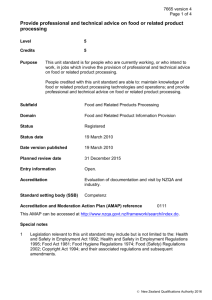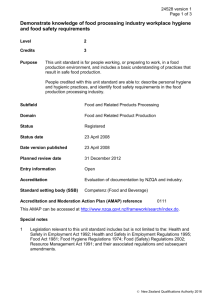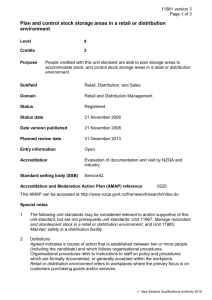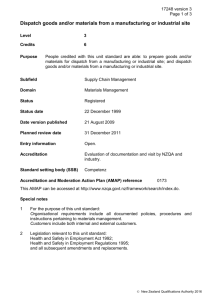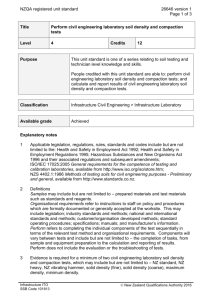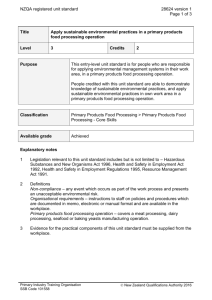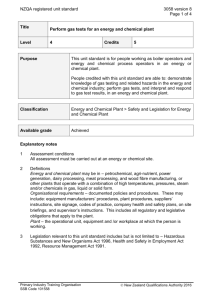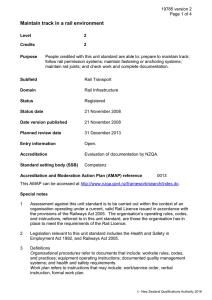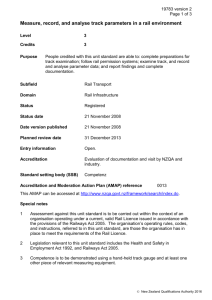25041 Demonstrate knowledge of railway signals
advertisement
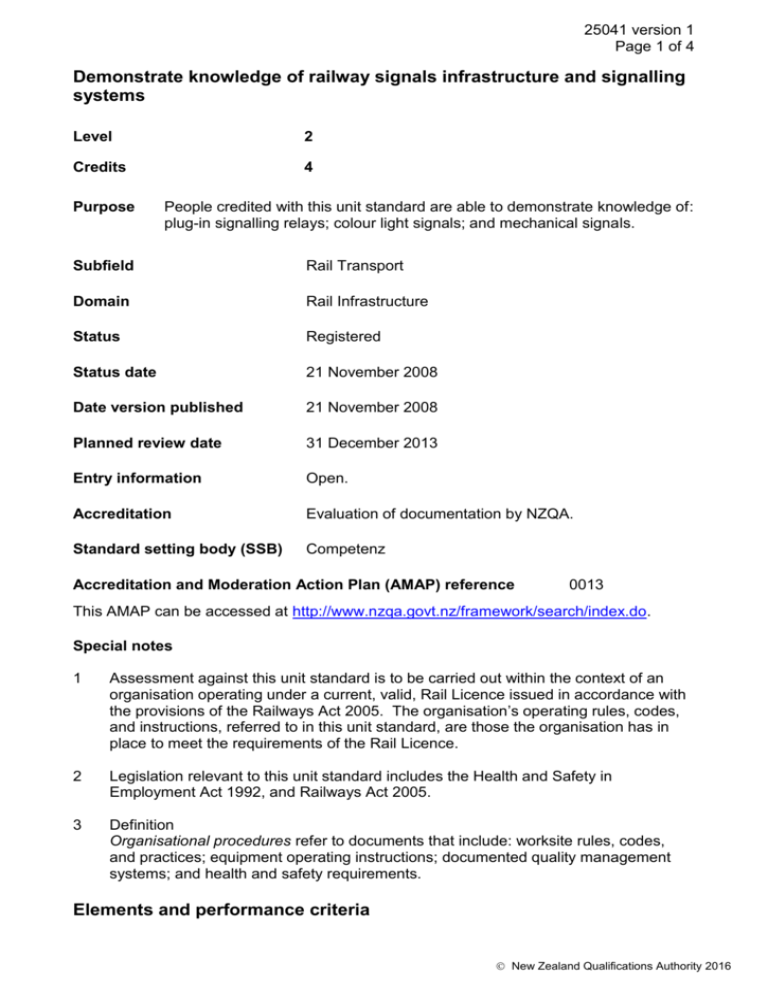
25041 version 1 Page 1 of 4 Demonstrate knowledge of railway signals infrastructure and signalling systems Level 2 Credits 4 Purpose People credited with this unit standard are able to demonstrate knowledge of: plug-in signalling relays; colour light signals; and mechanical signals. Subfield Rail Transport Domain Rail Infrastructure Status Registered Status date 21 November 2008 Date version published 21 November 2008 Planned review date 31 December 2013 Entry information Open. Accreditation Evaluation of documentation by NZQA. Standard setting body (SSB) Competenz Accreditation and Moderation Action Plan (AMAP) reference 0013 This AMAP can be accessed at http://www.nzqa.govt.nz/framework/search/index.do. Special notes 1 Assessment against this unit standard is to be carried out within the context of an organisation operating under a current, valid, Rail Licence issued in accordance with the provisions of the Railways Act 2005. The organisation’s operating rules, codes, and instructions, referred to in this unit standard, are those the organisation has in place to meet the requirements of the Rail Licence. 2 Legislation relevant to this unit standard includes the Health and Safety in Employment Act 1992, and Railways Act 2005. 3 Definition Organisational procedures refer to documents that include: worksite rules, codes, and practices; equipment operating instructions; documented quality management systems; and health and safety requirements. Elements and performance criteria New Zealand Qualifications Authority 2016 25041 version 1 Page 2 of 4 Element 1 Demonstrate knowledge of plug-in signalling relays. Performance criteria 1.1 Relay identification system is described in accordance with organisational procedures. Range 1.2 Relay components are identified and their purpose is explained. Range 1.3 pick-up, drop-away, working. Types of relays are described in terms of their operation and suitability for use, in accordance with organisational procedures. Range 1.6 front, back, armature/heel, polar. Voltage is explained in terms of correct and safe relay operation. Range 1.5 contacts, contact spacers/keepers, armature, pivot, residual stud, coil, case, plugboard, seal, name plate, code pins. Contact points are identified and their purpose is explained. Range 1.4 standard, miniature. must include – track, latched, neutral line, biased line, time delay, non-vital; may include but is not limited to – polar, AC immune, slow pick, slow release, double element AC vane, twin. Effect of silver migration on relays and relay components is described in terms of system integrity. Element 2 Demonstrate knowledge of colour light signals. Performance criteria 2.1 Identification system used for signals is described in terms of controlled and automatic systems. 2.2 Signal components are identified and their purpose is explained. Range 2.3 base, mast, head/s, ladder, name plate, marker light/disc, ‘A’ light, low-speed light, close view sector, wide-angle lens, lamp, LED light unit. Lamp voltage is explained in terms of correct and safe signal operation. New Zealand Qualifications Authority 2016 25041 version 1 Page 3 of 4 2.4 Colour light signal systems are described in terms of their operation in accordance with organisational procedures. Range may include but is not limited to – double-line automatic, singleline automatic, centralised traffic control, track warrant control; evidence of two is required. 2.5 Effect of silver migration on signal components is described in terms of system integrity. 2.6 Placement of signal is described in accordance with organisational procedures. Range 2.7 distance from track centre, height above rail. Suitability of signal components is described in accordance with organisational procedures. Range base, mast, head/s, lens/es. Element 3 Demonstrate knowledge of mechanical signals. Performance criteria 3.1 Identification system used for signal equipment is described in accordance with organisational procedures. 3.2 Signal components are identified and their purpose is explained in terms of their function and operation. Range may include but is not limited to – base, mast, arm/s, ladder, lamp, lens, shunting disc target, reflectorised switch stand indicator. 3.3 Mechanical signals are described in terms of their operation in accordance with organisational procedures. 3.4 Placement of signal is described in accordance with organisational procedures. Range 3.5 distance from track centre, height above rail. Suitability of signal components is described in accordance with organisational procedures. Range may include but is not limited to – base, mast, arm/s, lens/es, reflectorised tape. New Zealand Qualifications Authority 2016 25041 version 1 Page 4 of 4 Please note Providers must be accredited by NZQA, or an inter-institutional body with delegated authority for quality assurance, before they can report credits from assessment against unit standards or deliver courses of study leading to that assessment. Industry Training Organisations must be accredited by NZQA before they can register credits from assessment against unit standards. Accredited providers and Industry Training Organisations assessing against unit standards must engage with the moderation system that applies to those standards. Accreditation requirements and an outline of the moderation system that applies to this standard are outlined in the Accreditation and Moderation Action Plan (AMAP). The AMAP also includes useful information about special requirements for organisations wishing to develop education and training programmes, such as minimum qualifications for tutors and assessors, and special resource requirements. Comments on this unit standard Please contact Competenz qualifications@competenz.org.nz if you wish to suggest changes to the content of this unit standard. New Zealand Qualifications Authority 2016
